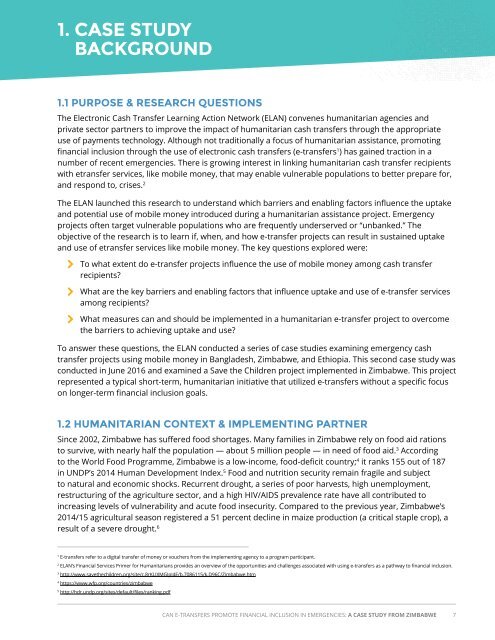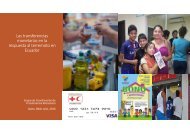Simatelele
2lF850q
2lF850q
Create successful ePaper yourself
Turn your PDF publications into a flip-book with our unique Google optimized e-Paper software.
1. CASE STUDY<br />
BACKGROUND<br />
1.1 PURPOSE & RESEARCH QUESTIONS<br />
The Electronic Cash Transfer Learning Action Network (ELAN) convenes humanitarian agencies and<br />
private sector partners to improve the impact of humanitarian cash transfers through the appropriate<br />
use of payments technology. Although not traditionally a focus of humanitarian assistance, promoting<br />
financial inclusion through the use of electronic cash transfers (e-transfers 1 ) has gained traction in a<br />
number of recent emergencies. There is growing interest in linking humanitarian cash transfer recipients<br />
with etransfer services, like mobile money, that may enable vulnerable populations to better prepare for,<br />
and respond to, crises. 2<br />
The ELAN launched this research to understand which barriers and enabling factors influence the uptake<br />
and potential use of mobile money introduced during a humanitarian assistance project. Emergency<br />
projects often target vulnerable populations who are frequently underserved or “unbanked.” The<br />
objective of the research is to learn if, when, and how e-transfer projects can result in sustained uptake<br />
and use of etransfer services like mobile money. The key questions explored were:<br />
To what extent do e-transfer projects influence the use of mobile money among cash transfer<br />
recipients?<br />
What are the key barriers and enabling factors that influence uptake and use of e-transfer services<br />
among recipients?<br />
What measures can and should be implemented in a humanitarian e-transfer project to overcome<br />
the barriers to achieving uptake and use?<br />
To answer these questions, the ELAN conducted a series of case studies examining emergency cash<br />
transfer projects using mobile money in Bangladesh, Zimbabwe, and Ethiopia. This second case study was<br />
conducted in June 2016 and examined a Save the Children project implemented in Zimbabwe. This project<br />
represented a typical short-term, humanitarian initiative that utilized e-transfers without a specific focus<br />
on longer-term financial inclusion goals.<br />
1.2 HUMANITARIAN CONTEXT & IMPLEMENTING PARTNER<br />
Since 2002, Zimbabwe has suffered food shortages. Many families in Zimbabwe rely on food aid rations<br />
to survive, with nearly half the population — about 5 million people — in need of food aid. 3 According<br />
to the World Food Programme, Zimbabwe is a low-income, food-deficit country; 4 it ranks 155 out of 187<br />
in UNDP’s 2014 Human Development Index. 5 Food and nutrition security remain fragile and subject<br />
to natural and economic shocks. Recurrent drought, a series of poor harvests, high unemployment,<br />
restructuring of the agriculture sector, and a high HIV/AIDS prevalence rate have all contributed to<br />
increasing levels of vulnerability and acute food insecurity. Compared to the previous year, Zimbabwe’s<br />
2014/15 agricultural season registered a 51 percent decline in maize production (a critical staple crop), a<br />
result of a severe drought. 6<br />
1<br />
E-transfers refer to a digital transfer of money or vouchers from the implementing agency to a program participant.<br />
2<br />
ELAN’s Financial Services Primer for Humanitarians provides an overview of the opportunities and challenges associated with using e-transfers as a pathway to financial inclusion.<br />
3<br />
http://www.savethechildren.org/site/c.8rKLIXMGIpI4E/b.7086115/k.D96C/Zimbabwe.htm<br />
4<br />
https://www.wfp.org/countries/zimbabwe<br />
5<br />
http://hdr.undp.org/sites/default/files/ranking.pdf<br />
CAN E-TRANSFERS PROMOTE FINANCIAL INCLUSION IN EMERGENCIES: A CASE STUDY FROM ZIMBABWE 7



